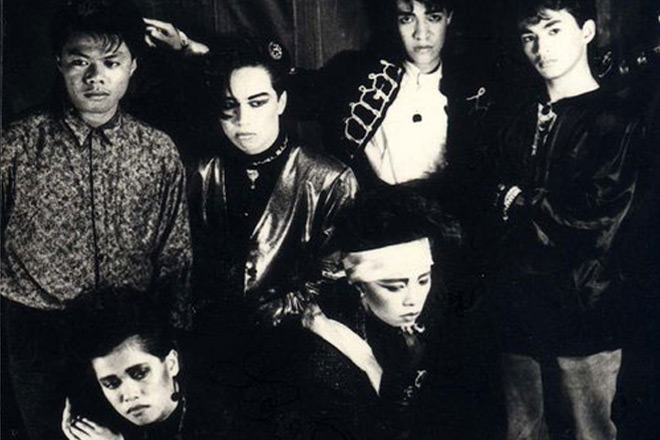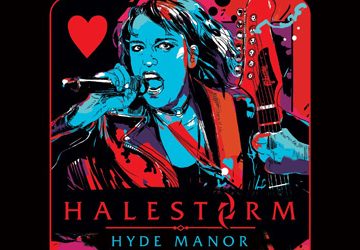
Formed in 1986, in Metro Manila, Philippines, Identity Crisis were Buddy Arceo (vocals), “Cool” Carla Abaya (vocals), Leni Llapitan (keyboards), Resty Cornejo (guitars), the late “Bogs” Arleigh Ambrosio (bass), and Marvin Mendiola (drums). In their early beginnings, the always Gothic-garbed group usually dished out covers of sure hits by then primary Gothic/New Wave–associated bands such as Gene Loves Jezebel (“Desire”), Siouxsie & the Banshees (“Cities in Dust”), X-mal Deutschland (“Matador”), The Adventures (“Two Rivers”), and Missing Persons (“Tears”). They immediately progressed into showcasing their own brand of Filipino Gothic music, which was practically a fusion of Gothic and New Wave with dashes of Filipino Worldbeat/Ethnic sound and bits of Progressive Rock.
Hailed as one of the premier bands in the Philippines in the late ’80s, Identity Crisis released their first album in 1988, on Dyna Records. Titled …Tale of Two, it was comprised by a set of well-crafted songs that significantly changed the musical landscape of the local scene. Many of the then emerging bands had started to employ synthesizers and heavily-effected guitars and various other sounds and textures into their music. This replaced the raw and Folk/Garage Rock–inspired ethos that was popular in the previous decade, as represented by the likes of Juan Dela Cruz Band (“Balong Malalim [Deep Well]”), Anak Bayan (“Ang Probinsyana [The Rural Girl]”), Maria Cafra (“Kumusta, Mga Kaibigan? [How Are You, Friends?]”), and Asin (“Masdan Mo ang Kapaligiran [Behold the Surrounding]”). American and British New Wave music had also arrived in the country, in their full glory.
Regarded now as a rare gem in one’s collection, …Tale of Two opened with the majestic concert anthem “Imagining Oktober,” whose ornate guitar ad-lib, rolling bassline, and drum beats exuded the same vibes as Tears for Fears’ “Suffer the Children.” This was followed by the slow, breezy, haunting ballad “Whispering Castles,” where Arceo’s chilling voice sent shiver down one’s spine, but which slowly transubstantiated into comforting warmth in one’s heart. The energy then rose to solar levels as the frenetic, staccato synthesizer–led Progressive stomper “Blank Pages” played next – with Cornejo’s distinctive lead guitar rushing like permanent waves and then dropping as if a script for a missing jester’s tears; cracking Abaya’s usually cool, low-register voice into a forcible, yet subdued declaration of the band’s lyrical manifesto.
…Tale of Two’s only Filipino-worded track, the semi-acoustic and semi-Synthpop “Sumigaw, Umawit Ka [You Shout and Sing]” was a beautiful, hopeful blossom amid the album’s overall foliage of darkness. Definitely a mid-album breather, it was one of Identity Crisis’ signature originals and a common fan favorite. The ensuing “My Sanctuary,” on the other hand, was the band in its most Gothic predisposition, both musically and lyrically; it was another display of their Progressive Rock tendencies, owing to Mendiola’s intricate drum patterns and complexity of arrangement. Then the bamboo-like percussion and kulintang-sounding keyboard melody of Llapitan in “When the Son Will Shine” was what gave …A Tale of Two its indelible stamp of Filipino identity – upbeat, ethnic, sweet, and a bit Twee. The penultimate track, “Requiem” was the pinnacle of Identity Crisis’ music – a perfect blend of Gothic, Glam, and New Wave – featuring a structurally rich template: ominous stanzas and melodic choruses, ghostly choral voices, Arceo and Abaya’s vocal interplay, Ambrosio’s tireless basslines, Cornejo’s metallic guitar ad-lib, and Mendiola’s syncopated rhythm.
Finally, Identity Crisis wrapped up their first offering aptly with the instrumental “Anthem,” further validating that their music was grounded not only on the aesthetics and flamboyance of New Wave and dark beauty of Gothic but also on the virtuosic allure of Progressive Rock music. The closer’s being an instrumental might have deemed itself trivial, and many listeners might have considered it a mere filler. However, upon retrospective assessment, it actually set the tone of the almost full-on Progressive Rock/Worldbeat predisposition of …Tale of Two’s follow-up, 1990’s Water Came Running, which sadly became Identity Crisis’ swan album. Two years after its release, the group disbanded. In 2011, they reformed but only for a grand reunion concert, after which they receded back to dormancy.
Such was the tale of the almost mythical Identity Crisis and their two grandiloquent masterpieces – truly rare gems from the Pearl of the Orient Seas. Thirty years have passed, yet …Tale of Two still resonates darkly and shines brightly in equal measures. Indeed, the musical legacy of Identity Crisis is one of the Philippines’ national treasures.






I remember the band Half life Half death ,the battle of band in pasay sports complex with mere mercy,ethnics faces etc.thats my recollection,,I’ve been to a lot of concert party,in the late 80’s and early 90’s…thank you brother for the memories,peace!!!,